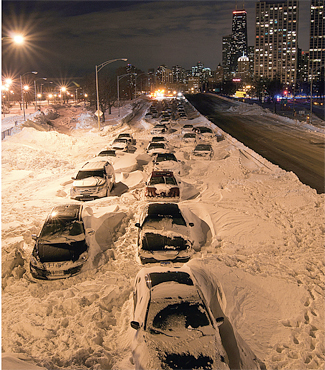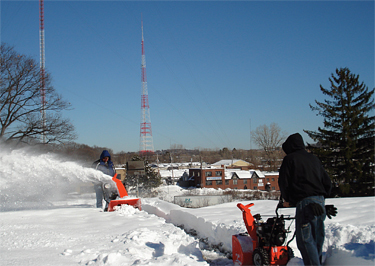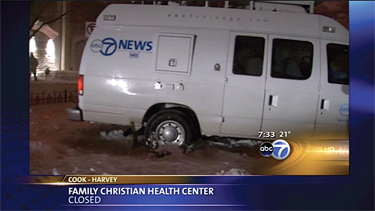TV Stations Become 'Blizzard Broadcasters'
CHICAGO—Even by Windy City standards, what's now called "The Great Chicago Blizzard of 2011" was extreme, with nearly two feet of snow on the ground by the time it ended on Feb. 2. Driven by gale-force winds, the blizzard literally buried hundreds of cars on the city's Lake Shore Drive freeway.

Motorists abandoned their cars on Chicago's Lake Shore Drive during the Feb. 1-3 blizzard. Photo by Jeff Lewis The rest of the Chicago area—and indeed most of the northeastern U.S. seaboard—was similarly inundated by snow and white-out conditions. "We recorded 20.2 inches of snow at O'Hare Airport," said Frank Whittaker, station manager and vice president of news at WMAQ-TV/NBC Chicago. "Officially, it was the third largest snowfall in Chicago's history!"
The blizzard that blasted Chicago, Philadelphia, and Boston—and all points surrounding and in-between—is just the latest of many blizzards this winter. For broadcasters in this region, dealing with 'blizzard broadcasting' raises many daunting challenges—but also offers the bonus of big ratings.
THE BIG ONE
Chicago-area TV stations knew the big one was coming on Tuesday, Feb. 1, and they were prepared to deal with it. "We had a strategic planning meeting on Monday to work out our staffing, and to decide what our programming would be," says WMAQ's Whittaker. "To ensure that our technical staff would be on hand for the early morning broadcasts—we opted to go live early at 4 a.m.—we put up over 20 people at a nearby hotel. We also got all our microwave trucks gassed. We also deployed a mobile camera that we use live while driving thanks to a Live-U video-over-cellular backpack, which sends the video back to the station over 3G commercial wireless."
BEING PREPARED
ABC-owned WLS Chicago got ready for the big storm days before it hit. "This is Chicago, so brutal winter storms are a part of life," says WLS News Director Jennifer Graves. "But we knew this was going to be a monster, even by our standards. So we arranged for people to take home microwave and news trucks, so that they could deploy as soon as they got out of bed. We also put up crucial staff at hotels, and made sure that one of our crews had a camera and Streambox in their truck, so that we could get live, rolling video at 4 a.m. Tuesday morning."

WCVB employees in Boston clear snow off the station's roof. As it turned out, the storm surpassed all expectations, and resulted in astounding visuals like the mass stranding and burial of cars on Lake Shore Drive. "Just getting around was a major challenge," says Whittaker. "One of the toughest treks was faced by reporter Alex Perez and his cameraperson Ozie Baldwin. Their job was to cover the developing story on Lake Shore Drive. The closest they could get by truck was Lincoln Park. They then walked more than three miles in the blizzard carrying their equipment, and captured the unbelievable sight of a traffic jam buried under snow drifts on Lake Shore Drive."
WLS faced the same challenges, and came up with unique ways to illustrate them live to their viewers. "One of our reporters went home Monday night with a camera and a Streambox," says WLS President/GM Emily Barr. "The next day, he tried to get into work by car, sending us live reports along the way. As it turned out, he was unable to make it, so he tried taking the train—and ran into massive delays there as well. All of his adventures were used on-air, to give our audience a first-hand look of what the storm was doing to us."
One of the station's news trucks also got stuck in the snow, which made for entertaining live cut-ins. "In particular, showing how long it took for a tow truck to arrive and pull our crew out spoke volumes about the weather conditions," says WLS Assistant News Director Janet Hundley.
The Feb. 1-2 storm that battered Chicago was equally brutal to other northeastern U.S. cities.

WLS's ABC7 news van was not immune from the hazardous conditions. In Boston, Hearst ABC affiliate WCVB-TV confronted the same logistical problems, plus had to keep its infrastructure from failing. "All of the freezing and sleet messed with the seals in our truck microwave masts," says Dave Kaylor, WCVB's director of engineering. "But it was our building that caused us the most concern. We have a large flat roof, and the 2.5-3 feet of snow that was accumulating on it worried us. Other roofs in our area had collapsed due to excessive snow loads, and we didn't want to become a news story ourselves. So, in the midst of everything, we had to hire contractors with snowblowers and shovels to clear the roof. We ended up with so much snow on the ground—8-10-foot piles in some areas—that we had to hire a trucking firm to haul it away."
In the City of Brotherly Love, WCAU/NBC 10 Philadelphia had followed the same precautions as WLS and WMAQ, including putting up critical staff at nearby hotels, pre-positioning news trucks, and renting extra SUVs from local car agencies. As for live shots? "Our crews are very smart," says Jim Barger, WCAU/NBC 10 Philadelphia director of broadcast operations & engineering. "They know to do their live shots beside a Wawa or Dunkin' Donuts, where they can get extra power, food and shelter if they need it. There's no point doing live hits from the middle of nowhere when the same great shots can be taken in a more accessible location."
South Copes with Unexpected Snow, IceLITTLE ROCK, ARK.—The winter storms that pounded the northeastern United States this season have also been playing havoc in parts of the South. In early February, Dallas was buried by 6 inches of snow and ice, forcing flight cancellations at Dallas Forth Worth International Airport. Further south in Houston, all they got was "just some ice on the roads," says Jeff Laird, assistant director of technology at KHOU-TV. "Being Southerners, we all freaked out." Also battling snow, sleet and freezing rain were parts of Oklahoma, Arkansas, Tennessee, Louisiana, Mississippi, and western North Carolina.
What is now being called the "Winter Storm of 2011" dumped up to 20 inches of snow in Arkansas on Feb. 9. "We got about 6 inches," says Shane Dietert, managing editor of Fox16 News in Little Rock. Although the snow slowed traffic, the blizzard was actually good news for the station. "It's hard to believe, but things went really well and we were able to get around," he says. "People stayed home and we did have some 18 wheelers who got stuck going up hills, but that was about it."
Fox16 capitalized on the storm by keeping its news crews on the road, and logging regular local cut-ins during the broadcast day. "We cover breaking news, so breaking weather news really played into our coverage plans," Dietert tells TV Technology. "We were doing 'team coverage' constantly on the 9th, and everything was about the weather. Between the snow and the Super Bowl, we've been extremely busy during the past two weeks—and people have been watching." PREPARATION IS EVERYTHING
Even in Chicago, the blizzard didn't cripple WMAQ or WLS. The same was true for Boston's WCVB and Philly's WCAU: All four stations stayed on air without interruption, providing extended local coverage to snowbound viewers.
"We are accustomed to working in these conditions," Barger says. "In fact, we are built to handle it. This is why we only use heavy trucks and have both back-up generators and UPS batteries at our station and transmitter sites. If the city's power goes out, it doesn't matter. We are self-contained, and have the fuel resources to run for 2-3 days—and an arrangement with a local fuel depot to keep our tanks topped.
"Our people are trained to work in bad weather," he adds. "In fact, all staff members are required to pass health and safety courses that include driver training. When we send them out in our Ford 350 vans, which typically weigh between 7,500-8,000 pounds, they know what they're doing."
Even food supplies matter: "We know that a newsroom runs on its stomach," says Emily Barr. "So we make sure that our staff have food at their disposal."
With the winter of 2010-–2011 having been one of the snowiest to hit the eastern seaboard in decades, the stations interviewed here are prepared to face the next big one. Whenever it hits, all four intend to be fully stocked, prepped and ready to hit the streets.
"This is what we do, and what our viewers love to watch," says WLS' Barr. "In fact, snowstorms are great for our ratings. They really show our viewers what we can do for them, and why local TV news is so important to their lives."
Get the TV Tech Newsletter
The professional video industry's #1 source for news, trends and product and tech information. Sign up below.
